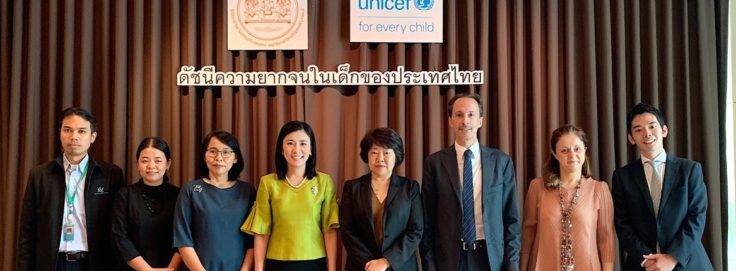
Search
Thailand’s child multidimensional poverty index is launched by NESDC and UNICEF with OPHI support

Photo (left to right): Dr. Chirawat Poonsab, National Statistical Office; Ms. Chayanit Wangdee, UNICEF; Ms. Montip Sumpunthawong, NESDC; Dr. Saipin Chotivichien, Ministry of Public Health; Ms. Jinanggoon Rojananan, NESDC; Mr. Thomas Davin, UNICEF; Ms. Christina Popivanova, UNICEF and Mr. Tomoo Okubo, UNICEF.
National Economic and Social Development Council (NESDC) and UNICEF Thailand today released the Child Multidimensional Poverty Index (Child MPI), a newly developed methodology to measure multiple deprivations faced by children beyond monetary poverty in Thailand.
The new study highlighted that about 22 per cent of children are living in multidimensional poverty with the highest deprivation in the areas of education and health. Multidimensional child poverty rates were found to be higher in rural areas and in particular, in the Northeast region.
Thailand has become one of the first countries in the world to develop a child focused MPI, which was developed under the partnership of NESDC and UNICEF with technical support from Oxford Poverty and Human Development Initiative (OPHI), Oxford University. The child MPI, based on using data from 2015-2016 Multiple Indicator Cluster Survey (MICS), takes a broader and more comprehensive concept of poverty than monetary poverty alone. The analysis reflects on four areas of deprivations that children face: education, child welfare, living standards and health.
The study found that child poverty rates were higher in rural areas (23 per cent) than urban areas (19 per cent), with the highest rates found in the Northeast region, followed by the North region, while the lowest rate was in Bangkok. When analysing the severity of poverty among those who are multidimensionally poor, the results also found that Mae Hong Son and Tak are the two provinces with the highest severity of poverty.
The drivers of multidimensional poverty vary by region and province, depending on the context. Nationally, among the different areas of deprivations, deprivation in learning and education, such as not being engaged in learning activities with caregivers or not attending school, contributed to the most child poverty (42 per cent), followed by nutrition (15 per cent). In Satun province, deprivation in education and learning contributed to child poverty at a much higher rate of 57 per cent. The deprivation in health dimension was a major driver of multidimensional poverty in the Northeast region.
Thomas Davin, UNICEF Representative for Thailand, welcomed the new tool that puts children at the heart of poverty analysis. “The Child Multidimensional Poverty Index is an important tool for achieving the principle of leaving no one behind under the Sustainable Development Goals efforts. It presents reliable data to identify children who are most vulnerable, by offering detailed information on poverty in its various dimensions beyond monetary income, such as education and health. Having the baseline data for Thailand gives all of us a remarkable starting point and will guide national budgeting and policy making process. UNICEF is committed to working with partners to further strengthen policies and programmes to ensure that no child in Thailand has to live in poverty, in any form or dimension,” said Davin.
The analysis reveals the link between the education level of the head of the family and a child’s multidimensional poverty. The multidimensional poverty level was also found to vary among different age groups. Children from the youngest age group (0-4) were more likely to be poor, with poverty rate of 42 per cent. On the other hand, adolescents from age group (15-17 years) were facing more severe levels of poverty than younger children, according to the findings.
Importantly, the study points to a significant reduction in child poverty between 2005 and 2016 both in terms of rates of children living in multidimensional poverty, as well as severity, reflecting the remarkable progress Thailand has made in reducing child poverty in all its dimensions over the last decade. As Thailand becomes an aging society, improving child wellbeing will contribute to the quality of human capital in the future.
The findings of the Child MPI provide an important analysis of the needs of children, particularly those living in poverty. Such information can help the country further lift many children out of poverty and contribute to further development of the country, if policies and programmes are further strengthened to meet the needs of vulnerable children.
The MPI will be regularly analysed to continually track the deprivation levels of children in Thailand, to ascertain the effectiveness of policies and programmes, with the next results expected at the end of 2020.
Thailand’s Child MPI Report is available here.
Photo credit: UNICEF/Worrawut Chumanee















